
Valletta is an administrative unit and the capital of Malta. Located on the main island, between Marsamxett Harbour to the west and the Grand Harbour to the east, its population within administrative limits in 2014 was 6,444. According to the data from 2020 by Eurostat, the Functional Urban Area and metropolitan region covered the whole island and has a population of 480,134. Valletta is the southernmost capital of Europe, and at just 0.61 square kilometres (0.24 sq mi), it is the European Union's smallest capital city.
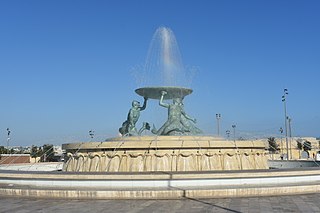
The Tritons’ Fountain is a fountain located just outside the City Gate of Valletta, Malta. It consists of three bronze Tritons holding up a large basin, balanced on a concentric base built out of concrete and clad in travertine slabs. The fountain is one of Malta's most important Modernist landmarks.

City Gate is a gate located at the entrance of Valletta, Malta. The present gate, which is the fifth one to have stood on the site, was built between 2011 and 2014 to designs of the Italian architect Renzo Piano.

Fontana del Moro is a fountain located at the southern end of the Piazza Navona in Rome, Italy. It depicts a nautical scene with tritons, dolphins, and a conch shell. It was originally designed by Giacomo della Porta in the 1570s with later contributions from Gian Lorenzo Bernini in the 1650s. Bernini sculpted a large terracotta model of the central figure, which Giovanni Antonio Mari used as a guide when sculpting the final figure. There is a debate around whether or not the central figure was intended by Bernini to depict a Moor. Some of the original sculptures were moved to the Galleria Borghese in 1874. In 2011, the fountain was vandalized.

Gabriel Caruana was a Maltese artist who worked primarily in ceramics. He studied at the Malta School of Art (1953–59), the Accademia Pietro Vannucci in Perugia (1965), the School of the Detroit Society of Arts and Crafts (1966) and the Istituto Statale per la Ceramica in Faenza (1967).

St John's Square is found in front of St John's Co-Cathedral in Valletta, the capital of Malta. It has several outdoor cafés, surrounded by a graceful arcade.

The Metropolitan Cathedral of Saint Paul, commonly known as St Paul's Cathedral or the Mdina Cathedral, is a Roman Catholic cathedral in Mdina, Malta, dedicated to St. Paul the Apostle. The cathedral was founded in the 12th century, and according to tradition it stands on the site of where Roman governor Publius met St. Paul following his shipwreck on Malta. The original cathedral was severely damaged in the 1693 Sicily earthquake, so it was dismantled and rebuilt in the Baroque style to a design of the Maltese architect Lorenzo Gafà between 1696 and 1705. The cathedral is regarded as Gafà's masterpiece.
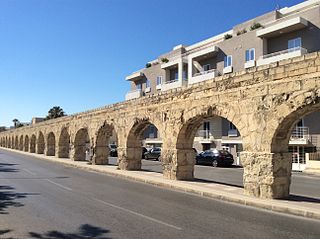
The Wignacourt Aqueduct is a 17th-century aqueduct in Malta, which was built by the Order of Saint John to carry water from springs in Dingli and Rabat to the newly built capital city Valletta. The aqueduct carried water through underground pipes and over arched viaducts across depressions in the ground.

The fortifications of Valletta are a series of defensive walls and other fortifications which surround Valletta, the capital city of Malta. The first fortification to be built was Fort Saint Elmo in 1552, but the fortifications of the city proper began to be built in 1566 when it was founded by Grand Master Jean de Valette. Modifications were made throughout the following centuries, with the last major addition being Fort Lascaris which was completed in 1856. Most of the fortifications remain largely intact today.
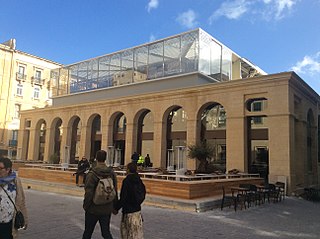
Is-Suq tal-Belt, also known as the Covered Market, is a 19th-century market hall located in Valletta, Malta. It is notable for being the first building in Malta to be constructed mostly of iron. The building was severely damaged in World War II, and the rebuilding was insensitive to the original structure. Further alterations were made in later decades, and the market began to decline in the 1970s. An attempt to rebrand it as a shopping arcade known as Ixtri Malti in the 1980s was unsuccessful. The market continued to decline until it was renovated in 2016–17, and reopened as a food market in January 2018.
Stephen C. Spiteri is a Maltese military historian, author, lecturer and preservationist. His work mainly deals with the military history of Malta, particularly military architecture, and he is regarded as the "leading expert on Malta's fortifications."

Ġnien is-Sultan, also known as the Giardino della Marina, the Grand Master's Garden or Lascaris Garden, was a garden in Valletta, Malta. It was established in the 17th century by Giovanni Paolo Lascaris, and it included a summer residence for the Grand Master. The garden included several Baroque elements designed by Francesco Buonamici.

Maltese Baroque architecture is the form of Baroque architecture that developed in Malta during the 17th and 18th centuries, when the islands were under the rule of the Order of St. John. The Baroque style was introduced in Malta in the early 17th century, possibly by the Bolognese engineer Bontadino de Bontadini during the construction of the Wignacourt Aqueduct. The style became popular in the mid to late 17th century, and it reached its peak during the 18th century, when monumental Baroque structures such as Auberge de Castille were constructed.

Emanuele Luigi Galizia was a Maltese architect and civil engineer, who designed many public buildings and several churches. He is regarded as "the principal Maltese architect throughout the second half of the nineteenth century".
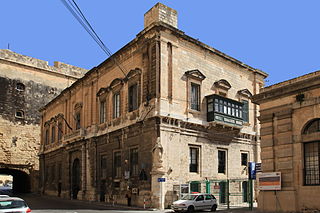
Giuseppe Bonici (1707–1779) was a Maltese architect and military engineer. He held the post of Capomastro delle Opere della Religione and was the principal architect of the Order of St. John from 1761 until his death. He designed several notable buildings; his masterpiece was the Customs House in Valletta.
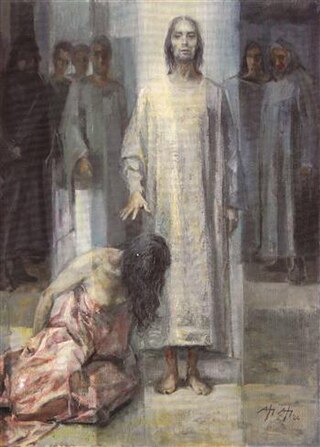
William Apap was a Maltese artist. He was born in Valletta, Malta, on 26 June 1918. He was the youngest member of a family that included the sculptor Vincent Apap and musician Joseph Apap.
Vincent Apap, OBE was a Maltese sculptor who is well known for designing various public monuments and church statues, most notably the Triton Fountain in Valletta. He has been called "one of Malta's foremost sculptors of the Modern Period" by the studio of Renzo Piano.

Alziro Bergonzo was an Italian architect and painter. His primary style was the rationalized Stile Littorio.
Giorgio Pullicino was a Maltese painter, architect, and professor of drawing and architecture at the University of Malta. He is known for his harbour views painted in a number of media, and he is also considered to be one of the first neoclassical architects in Malta. He produced designs for a number of buildings, but the only structure which is definitely proven to have been designed by him is a monumental obelisk known as the Spencer Monument. However, several other buildings including the Monument to Sir Alexander Ball are widely attributed to him.
Romano Fortunato Carapecchia (1666–1738) was an Italian Baroque architect who was active in Rome, Malta and Sicily. His designs helped transform Malta's capital Valletta into a Baroque city in the first few decades of the 18th century.
















